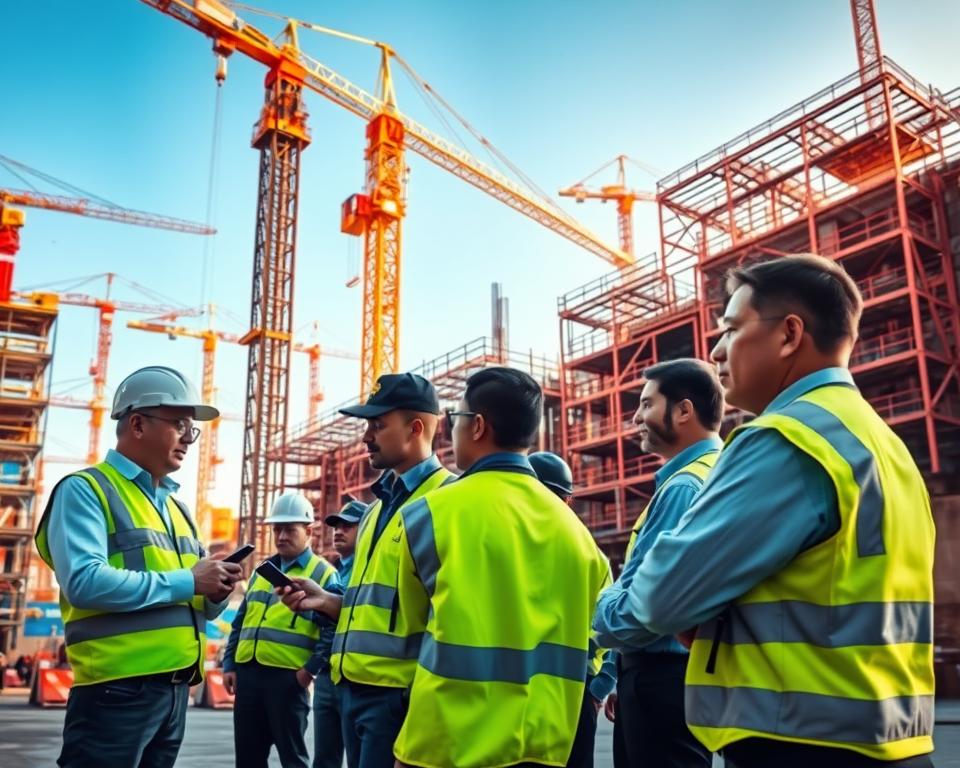Improve Your Project’s Job Site Safety Today
Envision stepping onto your worksite the next day just to discover critical equipment stolen or machinery vandalized. How soon could obstacles like these derail deadlines as well as budgets? Construction ventures frequently house premium assets in unprotected spaces, thus leaving them prone to theft. Lacking sufficient security measures, you are not merely putting at risk gear—you’re jeopardizing everything your workforce has created.
Burglars frequently target areas lacking extensive monitoring, particularly at night. The theft of portable machinery itself costs companies millions each year. Delays caused by replacing taken items and repairing damage bring stress as well as unexpected expenses. Thankfully: proactive commercial security guards security planning will convert weaknesses into strengths.
Divine Protection Services specializes in tailored safety measures in dynamic environments. The approaches blend cutting-edge technology with field experience to maintain your assets safe. In the sections that follow, you will find practical steps to deter theft, control access, plus continue progress without sacrificing security.
Set to change how you protect your site? Let us examine real-world strategies that combine efficiency and solid protection.
Understanding the Basics of Construction Site Security
Annually, unprotected job sites experience millions in losses as a result of preventable issues. Open areas with high-value gear invite criminal activity, chiefly at night. Let us break down the main challenges and why early action matters.

Identifying Weak Spots
Unlocked storage containers, unattended materials, plus insufficiently illuminated spaces create easy targets. Industry data indicates a 40% surge in theft during summer when construction ramps up. Frequent security gaps are:
- Portable generators left overnight
- Copper wire kept in sight
- Lacking perimeter barriers
Expenses Exceeding Stolen Goods
One stolen excavator might delay schedules for weeks while insurance claims process. Vandalism repairs often exceed $5,000 per incident, rapidly draining budgets. Workers end up on overtime to compensate—doubling the productivity loss.
Safety studies show motion-activated lighting slashes after-hours incidents by 60%. Using obvious cameras alongside locked gates deters intruders by indicating high risk.
By addressing these fundamentals first, you build a solid base for more advanced tactics. Next, we’ll explore tailoring solutions to your location’s unique needs.
Evaluating Your Unique Job Site Security Requirements
Why certain sites are more at risk than others? Each job site has unique characteristics that determine its risks. Conducting a detailed assessment of your site’s layout, operations, and resources is key to creating effective defenses.
Pinpointing Location-Specific Risks
Start by mapping high-traffic zones and storage spots. Are high-value items sitting in poorly lit spots? Is fencing incomplete near public roads? According to one safety guide, blind spots in high-traffic areas lead to 35% of thefts after hours. Addressing these gaps early prevents headaches later.
Think about how storing supplies influences risk. E.g., copper wire stacked by makeshift gates creates a lure for thieves. Similarly, portable gear left exposed in fields invites theft. Tailored strategies might include:
- Configuring lights to operate during active hours
- Assigning secure storage for expensive gear
- Reconfiguring entry routes to minimize exposure
A tailored security blueprint safeguards both equipment and labor. Proactive measures reduce delays and keep budgets intact. Concentrating on your site-specific demands builds a defense that evolves with the project.
Putting Effective Security Measures in Place
Bright perimeter lights serve as more than illumination—they’re the first line of defense. Let’s explore practical upgrades that blend technology with smart design to protect your assets.
Lighting That Works Smarter
Motion-activated lights eliminate shadows where intruders hide. One contractor reduced nighttime breaches by 75% after installing these around storage areas. Combine them with:
- Solar-powered fixtures for remote zones
- Timed settings matching work hours
- Weatherproof options for longevity
Barriers That Do More
Sturdy fencing does more than mark boundaries—it slows down unauthorized entry. A case study showed chain-link barriers with anti-climb features cut trespassing attempts by 60%. Pick barrier types that:
- Resist vehicle collisions
- Enable oversight by patrols
- Include lockable access points
Prominent signage operates as a wordless guard. “No Trespassing” warnings paired with alarm system decals make intruders think twice. One team reported zero thefts after adding multilingual signs near entryways.
Current alarm solutions send live notifications to smartphones. Pair them with motion detectors and intelligent locks for multi-tiered defense. Schedule weekly checks with your crew to ensure all devices function properly—this small investment of time prevents big headaches later.
By implementing these measures now, you create a safer environment for workers and equipment. Routine tweaks maintain your approach’s effectiveness as projects change.
Harnessing Technology for Site Protection
Gone are the days of relying solely on padlocks and patrols. Current tech merges innovation with functionality, forming a safeguard that operates while you’re away. Let us review how advanced tech tools defend assets while maintaining workflow efficiency.
Ever-Vigilant Surveillance
Contemporary cameras go beyond recording, performing analysis. Using 4K resolution alongside motion detection allows them to detect odd behavior, such as someone hanging around storage units overnight. One contractor reduced theft by 82% using systems that send alerts to their phones. Options include:
- Solar-powered security units for distant areas
- All-weather camera models suited for extreme conditions
- IR-enabled cameras for crisp nocturnal footage
Recording nonstop catches every moment, and motion-based modes conserve power. “Combining both approaches cuts false alarms by 50%,” notes a recent tech report.
Advanced Entry, Enhanced Control
Access cards make tracking easy without impeding team speed. Scan-to-enter systems log who’s on-site and when—ideal for managing subcontractors. Benefits include:
- Real-time logs for audits
- Remote credential adjustments
- Syncing with alarm systems
One project manager shared: “We caught a delivery error fast because our logs showed exactly who accessed the equipment shed.” Security personnel remain essential, but technology covers routine inspections, letting them concentrate on critical zones.
These technologies enhance rather than substitute human decision-making. Blending established methods and cutting-edge tech yields a defense that adapts with your site.
Enhancing Protection Through Divine Protection Services
When did you last update your project’s security plan in response to fresh risks? Divine Protection Services distinguishes itself by customizing for each site. They begin by conducting thorough evaluations, charting risks from storage layouts to nearby crime trends. It’s not off-the-shelf security—it’s pinpoint accuracy.
Perks of a Tailored Security Consultation
Instead of generic solutions, they analyze your workflow and surroundings. Example: A highway job updated patrol paths reflecting adjacent foot traffic patterns. Outcome? No thefts over half a year. Their method includes:
- Field assessments by safety engineers
- Custom tech blends (drones + ground sensors)
- Monthly strategy updates as projects evolve
Expert Security Personnel and Guarding Strategies
Guards here aren’t just watchmen—they’re trained in conflict resolution and tech systems. A guard team averted $12k in losses by noticing odd behavior around fuel reserves. Their multilayer method blends:
- 24/7 patrols with randomized schedules
- Live data streams to handheld devices
- Quick-action emergency exercises
“We cut vandalism by 91% at affiliated sites,” says a senior official. Integrating human expertise and AI insights, they develop a proactive defense.
Methods to Stop Unauthorized Access and Theft
Consider intruders wandering onto your premises undetected. Open access points make job sites a magnet for opportunistic thieves. An unsecured gate or off-schedule delivery can open the door to theft—yet strategic planning thwarts intruders.
The Importance of Timing and Tracking
Arrange material arrivals during working hours to ensure supervision. A study reveals 68% of thefts take place during unmonitored overnight hours. Coordinating deliveries with crew availability makes sure items get logged and locked away right away
Locked storage zones with limited access points reduce temptation. Assign specific areas for high-value tools, and use tamper-proof containers. As one project manager noted: “When everything has a designated spot, missing items stand out fast.”
- Limit access to primary gates after hours
- Use RFID tags on equipment for real-time tracking
- Carry out unannounced inspections on shifts
Trained personnel play a key role. Guards patrolling boundaries and verifying IDs keep trespassers at bay. Integrate guards with digital logging of visitor entry and exit times.
Minor tweaks—such as shifting delivery schedules or moving storage containers—form significant theft barriers. Assess protocols every week to seal vulnerabilities before they escalate. Marrying logistics and protection ensures projects remain on schedule and within budget.
Guaranteeing Safety via Comprehensive Risk Planning
How will you respond if a storm inundates your storage area at 12 AM? Though cameras and fences serve as initial defenses, genuine safety derives from preparing for surprises. Merging insurance with emergency plans builds a net that propels projects forward even amid crises.
Insurance Combined with Real-World Planning
Sufficient insurance transforms disasters into controllable setbacks. A contractor sidestepped $78k in losses when thieves hit—insurance paid for replacements with no deadline impact. Yet, coverage alone isn’t sufficient. Match it with:
- Recorded equipment lists
- 24/7 emergency teams for security breaches
- Weather-responsive evacuation procedures
Review your plans each quarter. A Midwestern team averted injuries in a tornado by practicing shelter drills. Their drills lowered evacuation times by 63% against adjacent job sites.
Contemporary alarm systems sync with emergency alerts. When detectors pick up flooding or fire, they notify emergency services automatically. Such dual capabilities aid in preventing unauthorized access amidst crises.
Update risk assessments as projects evolve. New phases might require additional coverage or revised escape routes. One safety officer advises: “Consider your emergency plan a living document—it improves with each trial.”
By blending financial safeguards with practiced responses, you protect both assets and teams. Start small: review policies this week and schedule your first drill. Readiness now averts chaos later.
Addressing Common Security Challenges on Construction Projects
Securing a job site isn’t merely about installing cameras and fences—it involves daily collaboration and clever solutions. Team turnover, dynamic schedules, and site modifications can test even the strongest plans. One contractor shared: “We once had three different security teams in a month—consistency felt impossible.”
Handling Security Staff and Routine Procedures
High turnover rates make training and communication tough. Streamlined checklists help new hires quickly learn patrol routes and reporting steps. Example: Daily walkthroughs with photo records decreased unresolved problems by 45% on a Texas skyscraper site.
Using RFID tagging for equipment tracking cuts down losses. Combine them with secure storage areas for gear like power tools. Visible signage designating restricted zones further deters casual intruders. One Florida crew experienced a 30% decline in thefts by posting multi-language alerts near material stacks.
Pressure to meet deadlines often compels quick decisions. One solution? Pre-scheduled access logs for deliveries and subcontractors. This balances tight deadlines with controlled entry points. Weekly audits of storage trailers and fuel tanks add another layer of oversight without slowing work.
Job sites evolve rapidly—what was storage yesterday could be a concrete pour area tomorrow. Frequent team meetings make sure all staff understand updated protocols. As one manager noted: “When we review security tweaks during safety meetings, compliance improves naturally.” Minor tweaks keep security flexible as the project progresses.
Preserving Lasting Security with Optimal Practices
Consistency separates temporary fixes from lasting protection. Think of your safety plan as a daily habit—small, intentional actions add up to unshakable results. Routine reviews and evolving strategies uphold security during every stage of the project.
Creating Accountability via Routine
Daily walks let teams spot issues before they escalate. A quick scan of the perimeter might reveal a damaged section of fencing or an alarm sensor needing calibration. One project manager discovered a breached container in a morning perimeter check, saving $8k.
Thorough reports build records that boost accountability. Record weather conditions, gear status, and any odd events. “Our digital logs uncovered mismatched after-hours deliveries,” reported a safety officer in Arizona.
Merge physical barriers and technology for comprehensive security:
- Enhance fences using tamper-resistant connectors
- Test alarm systems weekly
- Utilize geofencing tools to oversee restricted sections
Review your strategy monthly to adapt with the job. When one Florida crew widened their site, they reconfigured patrol routes to cover new entryways—cutting blind spots by 70%. Kick off immediately: pair up for walkthroughs, make concise checklists, and mark successes. One expert noted: “Security is a marathon, not a sprint—each step matters.”
Bringing it All Together for a Secure Construction Site
Your project’s outcome relies on more than plans and helmets—it needs multiple security layers that shift with changing threats. Combining physical barriers like sturdy fencing with smart alarm systems creates a shield that deters trespassers day and night. Consistent patrols with expert security guards offer human vigilance, and motion-triggered lighting annihilates shadowed areas where thieves hide.
Preventing unauthorized access starts with simple steps: lock high-value tools in designated storage zones, update access codes weekly, and install visible cameras near entry points. Evidence indicates areas applying these practices experience 70% less theft and vandalism than unguarded sites.
Divine Protection Services specializes in developing customized solutions for variable sites. Their team merges advanced devices like infrared sensors with hands-on strategies—randomized patrol schedules, multilingual warning signs, and real-time breach alerts. A client sidestepped $50k in losses after the system spotted suspicious movement at the perimeter.
Prepared to fortify your protection? Kick off today by examining weak points and arranging a free consultation. By planning ahead and leveraging expert help, you’ll construct more than sites—you’ll gain tranquillity.
Frequently Asked Questions
Which hazards are most common on construction sites?
Trespassing, equipment theft, and property damage are primary worries. Wide-open areas, pricey gear, and isolated spots commonly lure thieves. Adverse weather and dim lighting further heighten risk.
How can I prevent theft after hours?
Install motion-sensing lighting, robust perimeter fencing, and clear surveillance signage. Secure high-value items in locked storage containers. Engage services like Divine Protection Services for overnight patrols and immediate alarm notification.
What security measures work best for temporary projects?
Modular fencing with anti-climb features, solar-powered cameras with cloud storage, and temporary access codes for workers. Motion detectors in key areas and daily gear inspections keep watch in evolving conditions.
Can technology replace physical guards?
Although drones and intelligent cameras boost surveillance, trained guards are still essential. Combining AI analytics and live guards, as some providers do, yields multi-tier security.
How do I control access without slowing work?
Set up RFID tags or biometric scanners for speedy validation. Designate entry points with clear signage and separate zones for deliveries. Align material drop-offs with crew presence to prevent unguarded stock.
Does insurance cover stolen materials?
Most insurance policies stipulate proof of appropriate safeguards such as alarm systems or monitored checkpoints. Document all security measures, maintain equipment inventories with serial numbers, and file police reports immediately after incidents.
How frequently must security protocols change?
Reevaluate measures every week as the project progresses. Emerging stages might warrant repositioning cameras, extending fencing, or revising access rosters. Perform random audits to verify that crews adhere to procedures uniformly.
What daily practices improve long-term safety?
Daily morning meetings to outline hazards, evening equipment shutdown routines, and nighttime perimeter scans. Use apps like SafeSite for real-time incident reporting and digital logs of all site activities.
Are visible cameras enough to deter trespassers?
Although useful, pair cameras with additional deterrents. Post “24/7 Surveillance” signs, use gravel paths to detect footsteps, and vary guard patrol times. For high-risk zones, install overt camera housings with blinking LEDs alongside hidden backup units.


